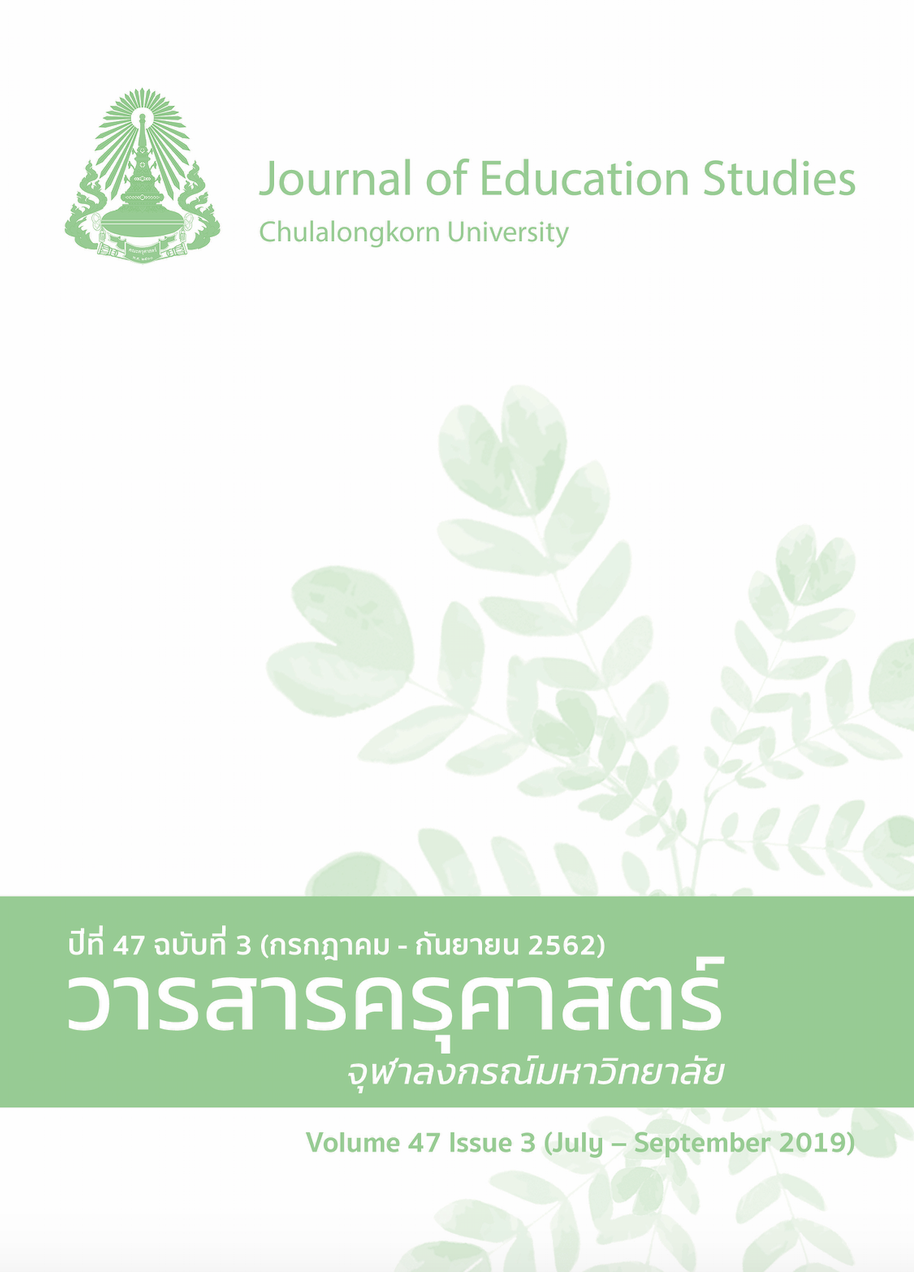Framework of Teaching Process Based on STEM Education and Communicative Approaches to Enhance Communication Abilities of Kindergarteners
Keywords:
TEACHING PROCESS, STEM EDUCATION, COMMUNICATIVE APPROACH, COMMUNICATION ABILITIES, KINDERGARTENERSAbstract
The purpose of this article was to present the result of a synthesis of teaching process based on STEM Education and Communicative Approaches to enhance communication abilities of kindergarteners which passed a quality inspection by content analysis that related to STEM Education, Communicative Approach and communication abilities of kindergarteners. The result of this study shows that the teaching process consists of 4 steps: 1) proposed problem presentation, 2) inquiry process, 3) knowledge relation, and 4) learning outcome conclusion in order to enhance communication abilities of kindergarteners in 3 aspects, which are the conversational interaction, the story or event narrative, and the symbolic creation.
References
ภาษาไทย
ปัทมา วาสสามัคคี. (2557). การเปรียบเทียบผลสัมฤทธิ์ทางการเรียนและเจตคติต่อการเรียนภาษาอังกฤษของนักเรียนชั้นประถมศึกษาปีที่ 4 ที่ได้รับการจัดการเรียนรู้ตามแนวการสอนภาษาเพื่อการสื่อสารโดยใช้ตำนานและนิทานพื้นบ้านกับการสอนแบบปกติ (วิทยานิพนธ์ปริญญามหาบัณฑิต ไม่ได้ตีพิมพ์). มหาวิทยาลัยศรีนครินทรวิโรฒ, กรุงเทพมหานคร.
พรพรรณ รำไพรุจิพงศ์. (2550). ทักษะการเขียนของเด็กปฐมวัยที่ทำศิลปสร้างสรรค์การ วาดภาพประกอบการพิมพ์ภาพ (วิทยานิพนธ์ปริญญามหาบัณฑิต ไม่ได้ตีพิมพ์). มหาวิทยาลัยศรีนครินทรวิโรฒ,
กรุงเทพมหานคร.
ภรณี คุรุรัตนะ และ คณะ. (2542). การเรียนรู้ของเด็กปฐมวัย (3-5 ปี). กรุงเทพมหานคร: เซเว่น พริ้นติ้งกรุ๊ป.
วศิณีส์ อิศรเสนา ณ อยุธยา. (2559). เรื่องน่ารู้เกี่ยวกับ STEM Education (สะเต็มศึกษา). กรุงเทพมหานคร: สำนักพิมพ์แห่งจุฬาลงกรณ์มหาวิทยาลัย.
สถาบันส่งเสริมการสอนวิทยาศาสตร์และเทคโนโลยี. (2557). สะเต็มศึกษา. กรุงเทพมหานคร: สถาบันส่งเสริมการสอนวิทยาศาสตร์และเทคโนโลยี.
สำนักงานคณะกรรมการการศึกษาขั้นพื้นฐาน. (2551). การจัดการศึกษาปฐมวัยตามหลักสูตรและการจัดการ เรียนรู้ที่สอดคล้องกับพัฒนาการทางสมอง. กรุงเทพมหานคร: โรงพิมพ์ชุมนุมสหกรณ์การเกษตรแห่งประเทศไทย.
สำนักงานคณะกรรมการการศึกษาขั้นพื้นฐาน. (2552). การส่งเสริมศักยภาพทางภาษาและการรู้หนังสือสำหรับเด็กปฐมวัย. กรุงเทพมหานคร: โรงพิมพ์ชุมนุมสหกรณ์การเกษตรแห่งประเทศไทย.
อารยา วานิลทิพย์. (2550). ผลของการจัดประสบการณ์ภาษาอังกฤษตามแนวการสอนภาษาเพื่อการสื่อสาร ที่มีต่อความเข้าใจคำศัพท์ของเด็กอนุบาลในโรงเรียนสังกัดเขตพื้นที่การศึกษากรุงเทพมหานคร (วิทยานิพนธ์ปริญญามหาบัณฑิต ไม่ได้ตีพิมพ์). จุฬาลงกรณ์มหาวิทยาลัย, กรุงเทพมหานคร.
ภาษาอังกฤษ
Adams, A. E., Miller, B. G., Saul, M., & Pegg, J. (2014). Supporting elementary pre-service teachers to teacher STEM through place-based teaching and learning experiences. Electronic Journal of Science Education, 18(5), 1-23.
Akritidou, A., Paraskeva, F., & Alexiou, A. (2014). Training the 21st century workforce of early childhood teachers in STEM Education through an eLearning environment. Retrieved from: https://www.icelw.org/program/ICELW%202014%Proceedings/ICELW2014/papers/Akritidou_Paraskeva_Alexiou.pdf
Barell, J. (2007). Problem-based learning: An inquiry approach. The United States of America: Corwin Press.
Bromley, K. D. (1992). Language arts: Exploring connections (2nd ed.). Boston, MA: Allyn and Bacon.
Bybee, R. W. (2013). The case for STEM Education challenges and opportunities. Arlington, VA: NSTA.
Delisle, R. (1997). How to use problem-based learning in the classroom. Virginia: Association for Supervision and Curriculum Development.
Dodge, D. T., & Bickart, T. S. (1998). Preschool for parent. Naperville, IL: Source Books.
Hmelo-Silver, C. E. (2004). Problem-based learning: What and how do students learn?. Educational Psychology Review, 16(3), 235-266.
Ilter, B. G. (2015). How does technology effect language learning process at an early age. Procedia-Social and Behavioral Sciences, 199(2015), 311-316.
Jalongo, M. R. (2003). Early childhood language arts (3rd ed.). Boston, MA: Pearson Education Group, Inc.
Lambros, A. (2002). Problem-based learning in K-8 classroom: A teacher’s guide to implementation. Thousand Oaks, CA: Corwin Press, Inc.
Littlewood, W. (2010). Communicative language teaching (30th ed.). New York: Cambridge University Press.
Moomaw, S., & Davis, J. A. (2010). STEM comes to preschool. Young Children, 65(5), 12-18.
Richards, J. C. (2006). Communicative language teaching today. New York: Cambridge University Press.
Richards, J. C., & Rodgers, T. S. (2001). Approaches and methods in language teaching (2nd ed.). New York: Cambridge University Press.
Richards, J. C., & Rodgers, T. S. (2014). Approaches and methods in language teaching (3rd ed.). New York: Cambridge University Press.
Shala, M. (2011). Early learning development standards for children age 0-6 years. Kosovo: The National and University Library of Kosovo.
Sulzby, E. (1990). Assessment of emergent writing and children’s language while writing. Englewood Cliffs, NJ: Prentice-Hall.
Thomas, K. F., Rinehart, S. D., & Wampler, S. K. (1992). Oral language, literacy and schooling: Kindergarten years. Reading Horizons, 33(2), 149-166.
Tsupros, N., Kohler, R., & Hallinen, J. (2009). STEM Education: A project to identify the missing components. Pennsylvania: Intermediate Unit 1 and Carnegie Mellon.
Vasquez, J. A., Sneider, C., & Comer, M. (2013). STEM lesson essentials integrating science, technology, engineering, and mathematics. New Hampshire: Heinemann.




